An Essential Overview of Co-Occurring Disorders in Treatment
Understanding co-occurring disorders is vital for effective substance use treatment, as these dual diagnoses involve the simultaneous presence of mental health conditions and substance use issues. Recognizing the prevalence, underlying mechanisms, and appropriate interventions can significantly enhance recovery outcomes and reduce the overlapping physical, emotional, and social impacts.
Defining Co-Occurring Disorders and Their Significance
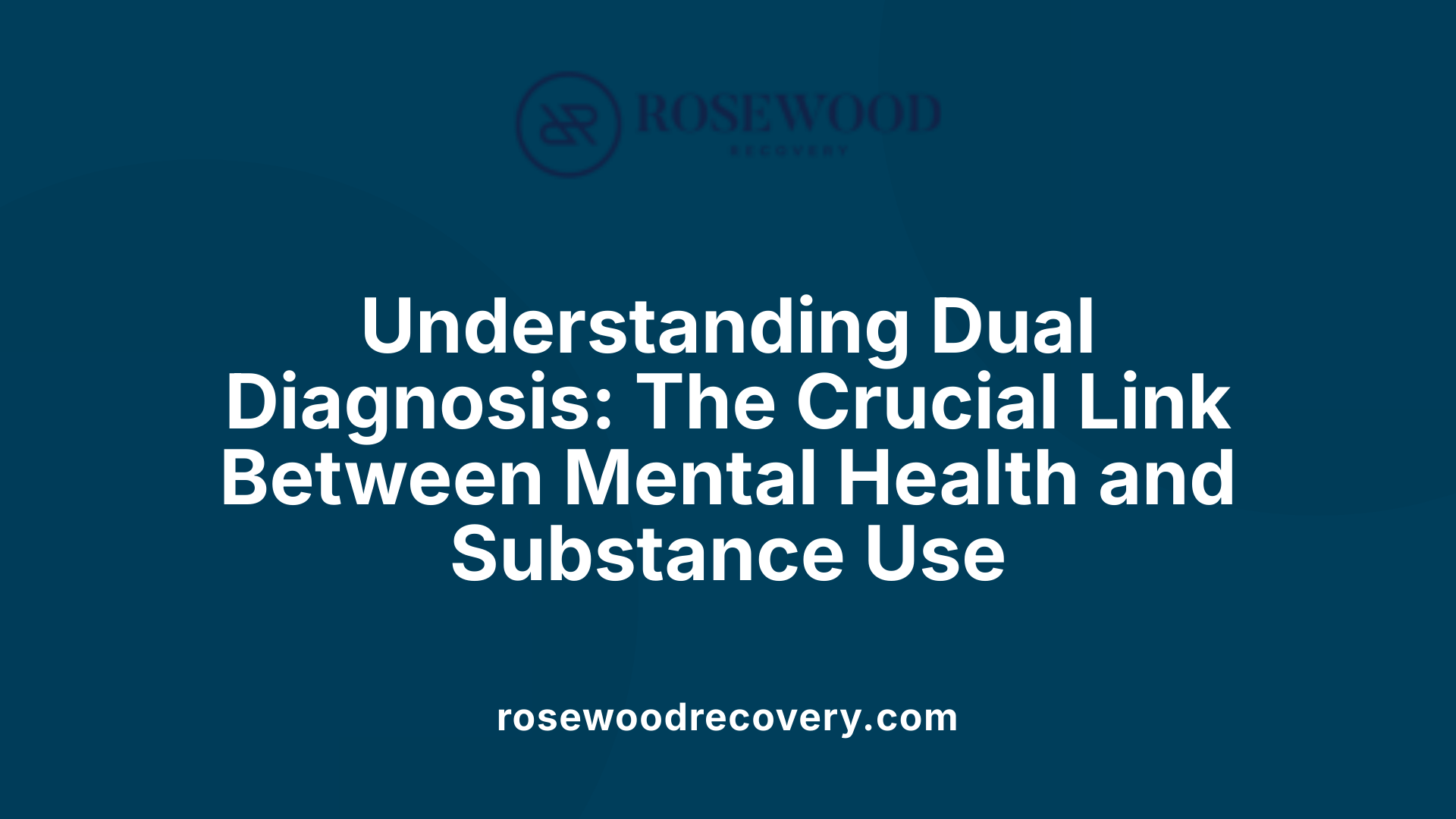
What are co-occurring disorders in substance use treatment?
Co-occurring disorders, also known as dual diagnosis, refer to the presence of both a mental health disorder and a substance use disorder (SUD) within the same individual. These conditions do not exist in isolation; instead, they interact, often worsening each other's symptoms. This interplay can make diagnosis and treatment more complicated.
Common mental health conditions involved include depression, anxiety, post-traumatic stress disorder (PTSD), bipolar disorder, and schizophrenia. On the substance use side, individuals might struggle with alcohol, opioids, stimulants, marijuana, or prescription drugs.
Recognizing and treating both disorders together is essential. An integrated treatment approach involves coordinated care that simultaneously addresses mental health and substance use issues. This may include therapy, medication, and ongoing support, all tailored to the person's needs.
Addressing co-occurring disorders effectively can significantly improve recovery chances, reduce relapses, and minimize the physical and emotional impacts associated with these intertwined conditions.
Prevalence and Epidemiology of Co-Occurring Disorders
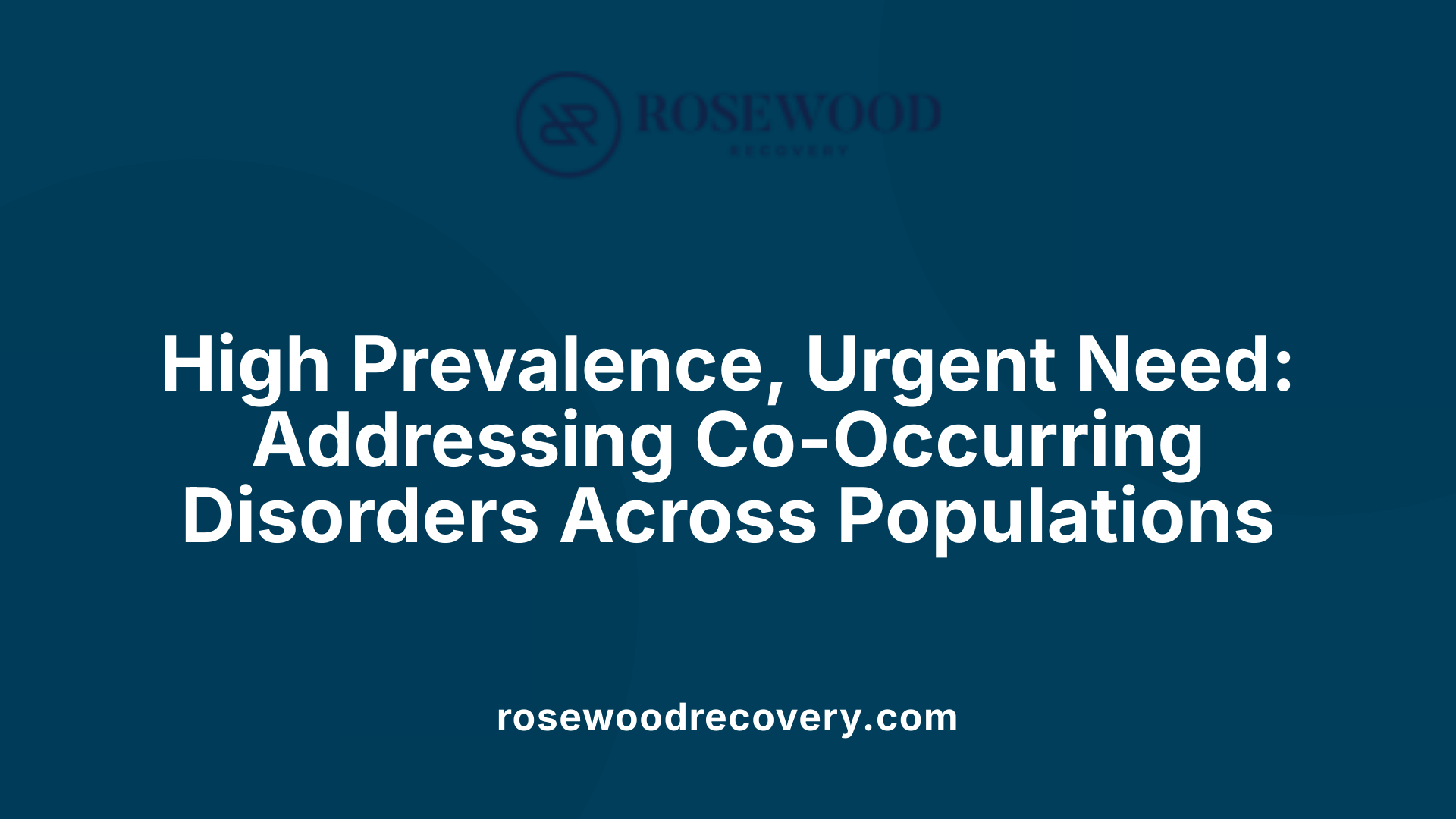 Co-occurring disorders are remarkably common among individuals affected by substance use issues. Recent studies, including data from the 2023 National Survey on Drug Use and Health, reveal that approximately 35% of adults with a mental health disorder also have a substance use disorder. Conversely, about 50% of those with a substance use disorder experience mental health challenges at some point in their lives.
Co-occurring disorders are remarkably common among individuals affected by substance use issues. Recent studies, including data from the 2023 National Survey on Drug Use and Health, reveal that approximately 35% of adults with a mental health disorder also have a substance use disorder. Conversely, about 50% of those with a substance use disorder experience mental health challenges at some point in their lives.
In the broader population, between 20% and 50% of individuals with mental health disorders are also affected by substance use problems. Conditions like anxiety, depression, PTSD, bipolar disorder, and personality disorders frequently coexist with substance misuse. Among adolescents and young adults, the rates are even higher, with over 45% of youth with mental health issues also battling substance use disorders.
The interconnection of these disorders poses significant public health concerns. Co-occurring conditions can complicate treatment, prolong recovery, and increase risks such as overdose, chronic diseases, and social instability. Despite their prevalence, less than half of affected individuals receive adequate integrated treatment, emphasizing gaps in healthcare access and utilization.
Various factors contribute to this high prevalence, including shared genetic vulnerabilities, adverse social environments, trauma exposure, and stress. Mental health symptoms often precede substance use as individuals attempt to self-medicate, which can further worsen their mental health, creating a challenging cycle.
Understanding these patterns is essential for developing better prevention and treatment strategies. Improving screening, expanding integrated services, and increasing awareness can help more individuals receive the tailored care they need to address both aspects of their health effectively.
| Population Group | Estimated Co-occurrence Rate | Notable Features |
|---|---|---|
| General Population | 20-50% | Shared risk factors include trauma and social stressors |
| Adolescents & Youth | Over 45% | High rates of mood, anxiety disorders, ADHD |
| Clinical Samples | Up to 65-72% | Comorbidities like depression, PTSD, and personality disorders |
| Specific Conditions | Varies by disorder | High prevalence in schizophrenia, bipolar disorder, and PTSD |
This high prevalence underscores the pressing need for integrated treatment approaches that simultaneously target both mental health and substance use issues to improve outcomes and reduce the burden on healthcare systems.
Interconnections Between Mental Health and Substance Use Disorders
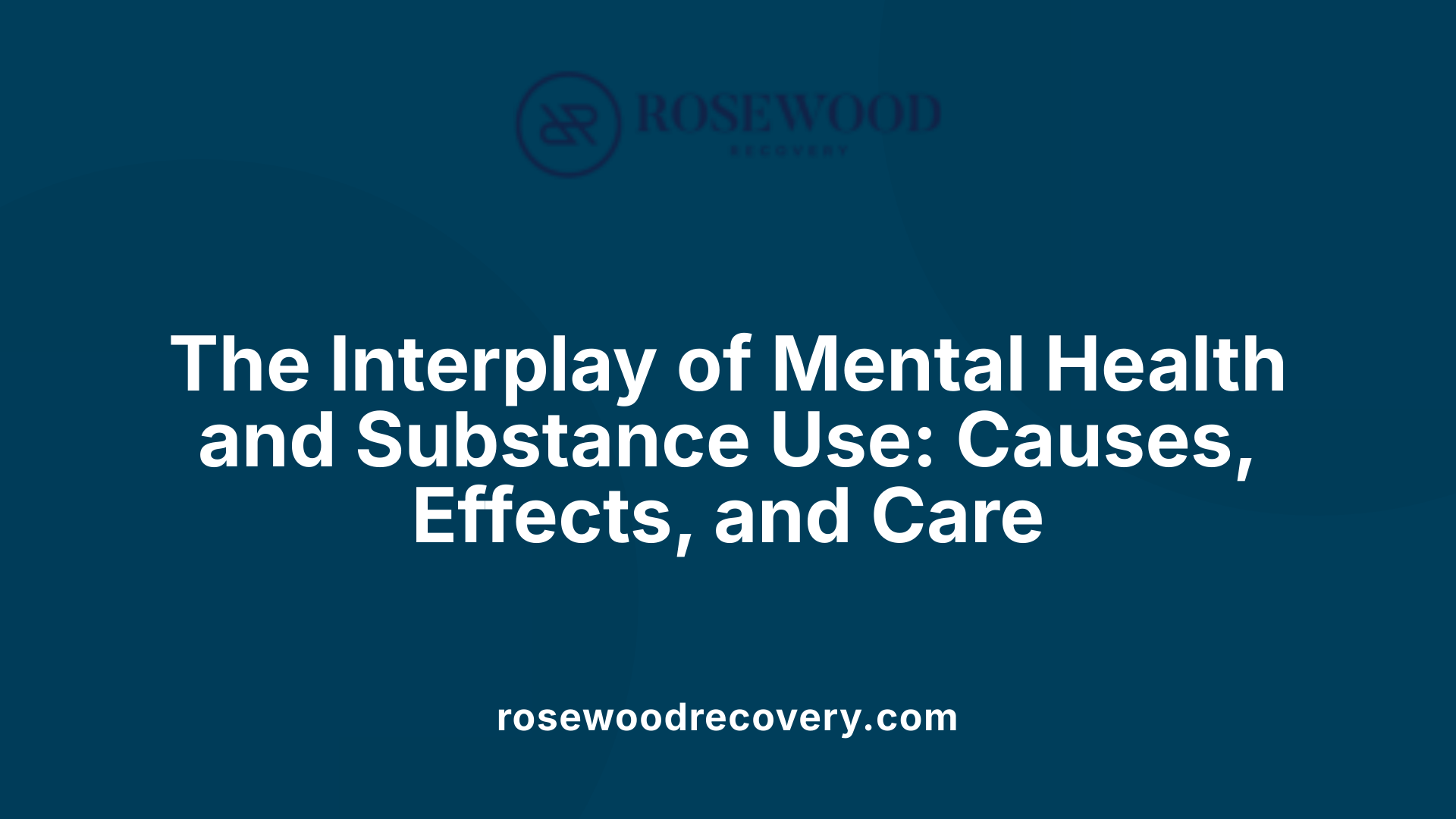
What is the relationship between mental health conditions and substance use disorders?
The connection between mental health issues and substance use disorders (SUDs) is intricate and influences each other significantly. Many people facing mental health challenges such as depression, anxiety, bipolar disorder, or schizophrenia are more susceptible to developing substance use problems. Often, individuals use alcohol, drugs, or other substances to self-medicate symptoms like anxiety or mood swings, seeking relief or temporary comfort.
Conversely, substance use can cause brain changes that mimic or worsen mental health conditions. For example, chronic drug or alcohol abuse can alter brain wiring, leading to or aggravating mood disturbances, hallucinations, or impaired decision-making. This creates a cycle where mental health issues increase the likelihood of substance use, and substance use, in turn, deepens mental health problems.
Underlying factors, including genetics, trauma, adverse social environments, and stress, contribute to both conditions' development. Childhood trauma, for instance, elevates the risk for both mental illnesses and substance misuse, reinforcing their interconnected nature.
Effective treatment calls for an integrated approach that simultaneously addresses both mental health and substance use disorders. Such coordinated care improves overall outcomes, reduces relapse likelihood, and supports long-term recovery. Addressing these issues together is essential because ignoring one can lead to challenges in managing the other, prolonging recovery and affecting quality of life.
Symptoms, Indicators, and Risk Factors
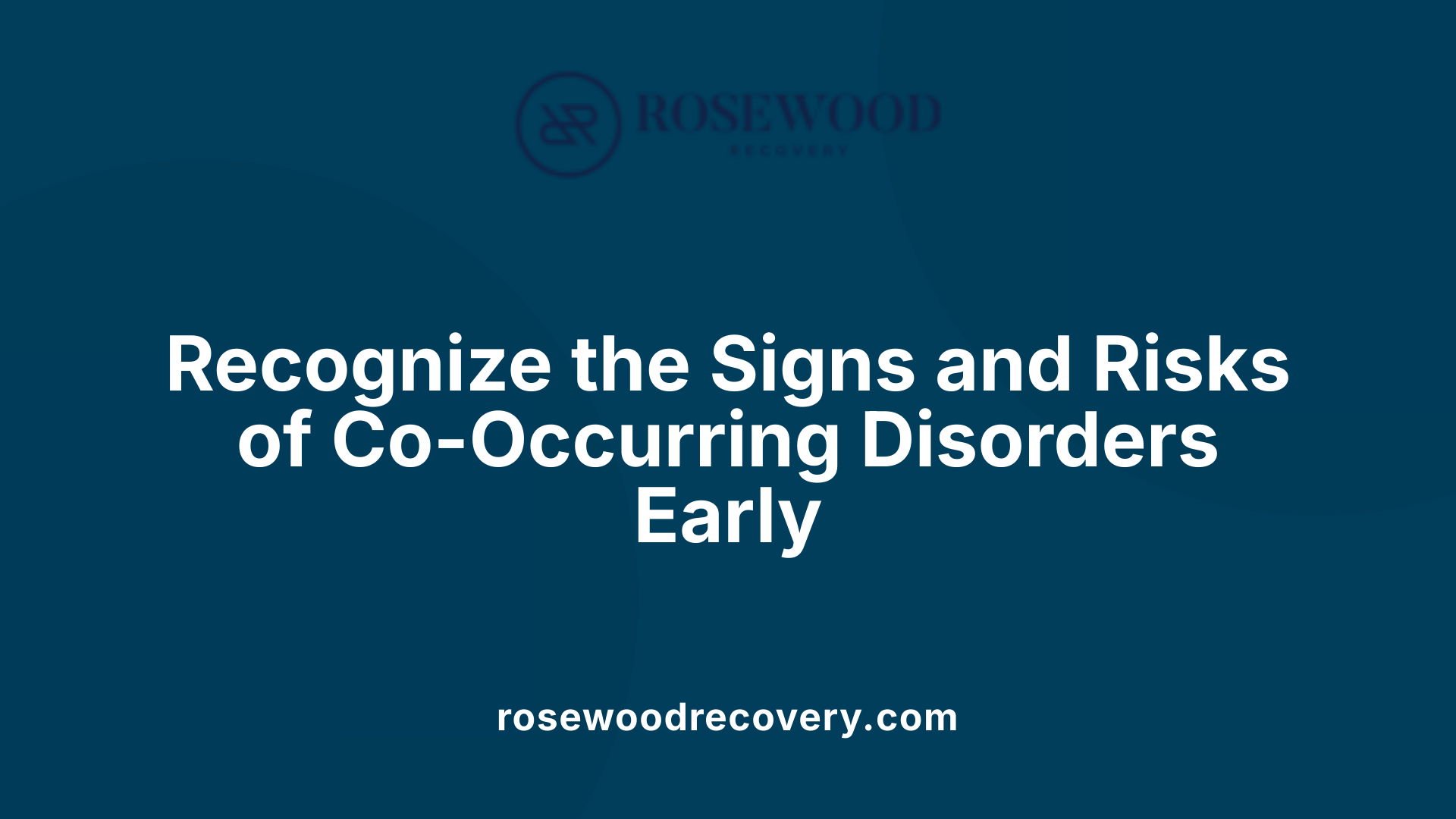
What are common symptoms and risk factors for co-occurring disorders?
Individuals with co-occurring disorders often exhibit a wide range of mental, behavioral, and physical symptoms that can make diagnosis and treatment challenging. Common mental health symptoms include extreme mood swings, persistent irritability, confusion, and difficulties with concentration. Sleep disturbances and thoughts of suicide are also frequently observed, highlighting the severity of these combined conditions.
Behavioral signs may involve withdrawal from social activities, risky behaviors, agitation, and impulsivity. People might show a decline in personal or professional functioning, or engage in substance misuse as a way to cope with their mental health issues.
Risk factors that increase the likelihood of developing co-occurring disorders are multifaceted. Genetic predispositions play a significant role, with inherited traits influencing susceptibility. Environmental influences such as adverse social conditions, childhood trauma—including physical or emotional abuse—and prenatal exposures can contribute as well.
Stress and traumatic experiences are particularly influential, potentially triggering both mental health issues and substance use as coping mechanisms. Additionally, dysfunctional family dynamics, poverty, and loss are important environmental risk factors.
The interaction between brain circuitry and trauma further complicates the picture. Changes in neural pathways related to stress, reward, and impulse control are common in individuals with co-occurring disorders. If left untreated, these conditions can lead to serious health complications, social difficulties, and barriers to effective treatment.
Thus, early identification of symptoms combined with understanding the underlying risk factors can facilitate timely and integrated interventions, improving long-term outcomes for affected individuals.
Biological and Neurobiological Underpinnings

What are some neurobiological insights into co-occurring disorders?
Understanding what happens in the brain when someone experiences both a mental health disorder and a substance use disorder offers valuable insights into these complex conditions. Research shows that individuals with dual diagnoses frequently have distinct alterations in neural pathways responsible for reward, stress regulation, and impulse control. These changes contribute to the difficulty in treating co-occurring disorders.
Both substance addiction and mental health conditions involve chronic changes in key brain structures. For example, addiction impacts areas like the basal ganglia, extended amygdala, and prefrontal cortex. These regions are essential for processing rewards, managing stress responses, and making decisions. When these areas are affected, individuals may experience impaired impulse control and heightened stress sensitivity.
Psychiatric conditions such as depression, PTSD, ADHD, and schizophrenia further influence these pathways. They often involve imbalances in neurotransmitter systems, including dopamine, serotonin, GABA, and glutamate. These chemicals are crucial for mood regulation, anxiety, cognition, and reward processing.
Advanced neuroimaging studies have revealed that people with co-occurring disorders often show structural and functional brain abnormalities. Gray matter loss, especially in frontal and limbic regions, correlates with symptom severity and responsiveness to treatment.
In summary, neurobiological evidence confirms that co-occurring disorders are rooted in complex alterations of brain circuits. These findings guide the development of targeted therapies aimed at normalizing disrupted pathways and improving outcomes.
| Brain Structures | Associated Functions | Neurotransmitter Systems | Impacts in Co-occurring Disorders |
|---|---|---|---|
| Prefrontal Cortex | Decision-making, impulse control | Dopamine, serotonin, GABA | Impaired regulation, increased impulsivity |
| Limbic System (including Amygdala) | Emotion regulation, stress response | Glutamate, serotonin, GABA | Heightened stress sensitivity, emotional dysregulation |
| Basal Ganglia | Reward processing | Dopamine | Altered reward sensitivity, cravings |
| Extended Amygdala | Stress and anxiety | GABA, CRF | Increased stress reactivity, anxiety symptoms |
How do trauma and stress hormones influence co-occurring disorders?
Trauma and chronic stress significantly shape neurobiological pathways involved in co-occurring disorders. Stress hormones like corticotropin-releasing factor (CRF) and hormones from the hypothalamic-pituitary-adrenal (HPA) axis become hyperactive in individuals with trauma histories. This hyperactivity affects brain regions responsible for emotional regulation and stress responses.
Elevated CRF levels are linked to symptoms seen in depression and PTSD, such as emotional distress and heightened drug cravings. These alterations can make individuals more vulnerable to substance use as a way to self-medicate distress or trauma symptoms.
Neurobiological studies show that persistent stress can lead to changes in brain connectivity, especially between the prefrontal cortex and limbic areas, reducing the ability to manage emotions and impulses effectively. This dysregulation increases the likelihood of developing both mental health issues and substance use problems.
What neuroimaging findings are associated with co-occurring disorders?
Neuroimaging techniques like MRI and PET scans have provided visual evidence of brain differences in people with co-occurring disorders. Common findings include gray matter volume reductions in the frontal cortex and anterior cingulate, which are critical for decision-making and emotional regulation.
Additionally, changes in the amygdala and reward pathways, particularly in the nucleus accumbens, are associated with increased cravings and emotional dysregulation. These structural and functional alterations are often more pronounced in individuals with dual diagnoses and are linked to poorer treatment outcomes.
By understanding these neurobiological mechanisms, clinicians can better tailor interventions to target the specific brain circuits involved, ultimately improving recovery prospects for those with complex co-occurring conditions.
Diagnosis and Assessment Strategies
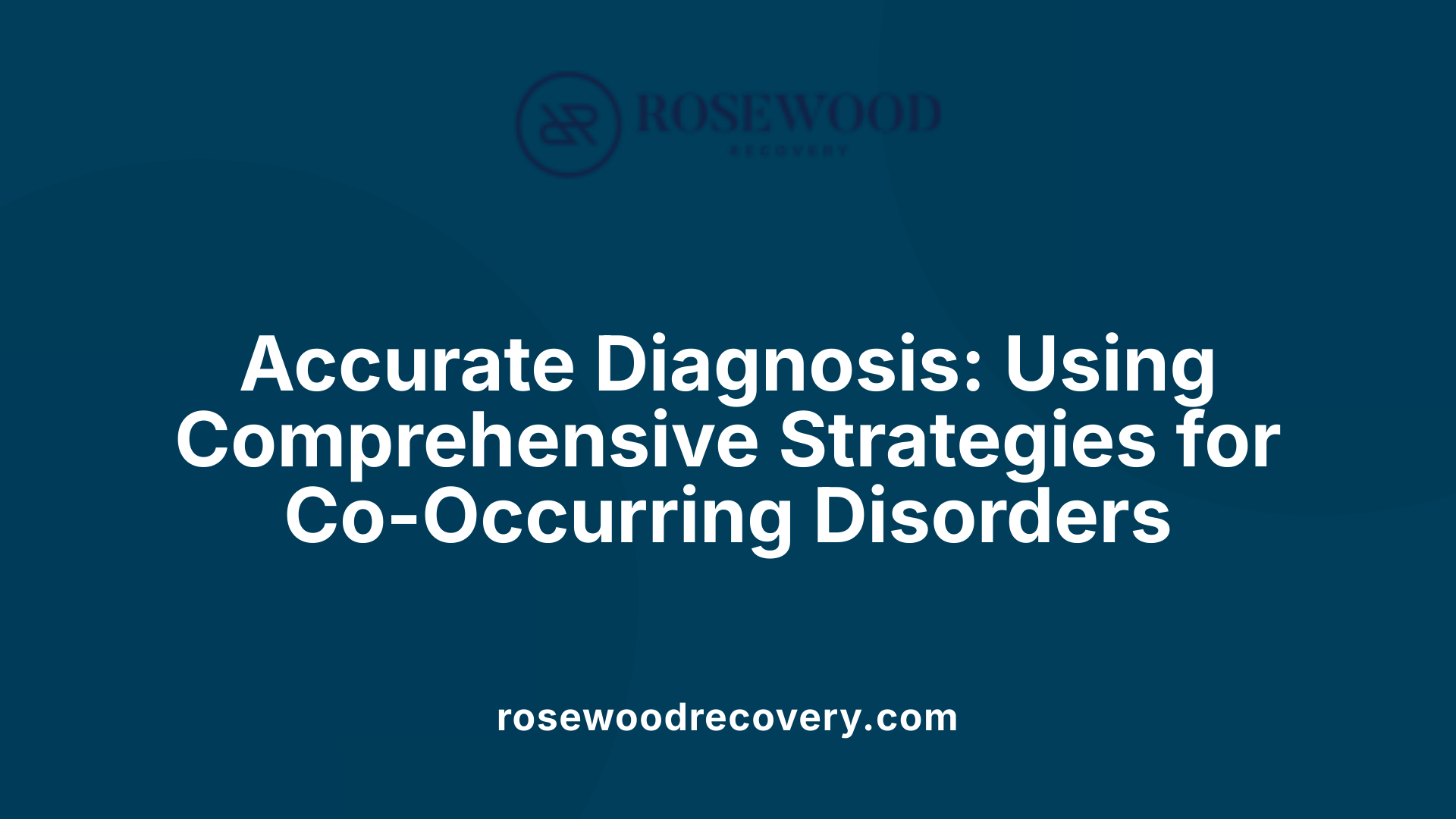
How are co-occurring disorders diagnosed and assessed?
Diagnosing and assessing co-occurring disorders involves a careful, multi-step process to ensure an accurate understanding of both mental health and substance use issues. Healthcare providers begin with screening tools designed to identify potential problems in each area. Validated instruments such as the Alcohol Use Disorders Identification Test (AUDIT), Drug Abuse Screening Test (DAST-10), and Mental Health Screening Forms (MHSF-III) are commonly used to flag possible concerns.
Once initial screening indicates potential issues, a comprehensive biopsychosocial evaluation is conducted. This assessment examines several key areas:
- Client History: Past mental health diagnoses, substance use patterns, medical history, and social background.
- Current Symptoms: Nature and severity of mental health symptoms and substance use behaviors.
- Strengths and Supports: Existing resilience factors, family, and community resources.
- Cultural Factors: Cultural beliefs, language, and social norms that influence health behaviors.
- Impacts and Disability: How symptoms interfere with daily functioning, employment, and relationships.
- Stage of Change and Motivation: Readiness to change substance use and mental health behaviors.
Standardized diagnostic tools, like the Structured Clinical Interview for DSM-5 (SCID-5) or the Addiction Severity Index (ASI), are often used during this stage to further clarify diagnoses. These tools help clinicians understand the complex interplay between mental health symptoms and substance use, especially when symptoms overlap or influence each other.
The assessment process emphasizes understanding the individual's unique circumstances, cultural background, and trauma history to develop an effective, personalized treatment plan. It is essential that clinicians maintain a trauma-informed and culturally sensitive approach to ensure trust and engagement.
Ongoing assessment is vital, as co-occurring disorders often fluctuate over time. The continuous evaluation of symptoms and response to treatment allows adjustments that optimize recovery outcomes. This integrated, nuanced approach ultimately enhances the accuracy of diagnosis, the relevance of treatment interventions, and the overall chances of successful recovery.
Treatment and Intervention Strategies
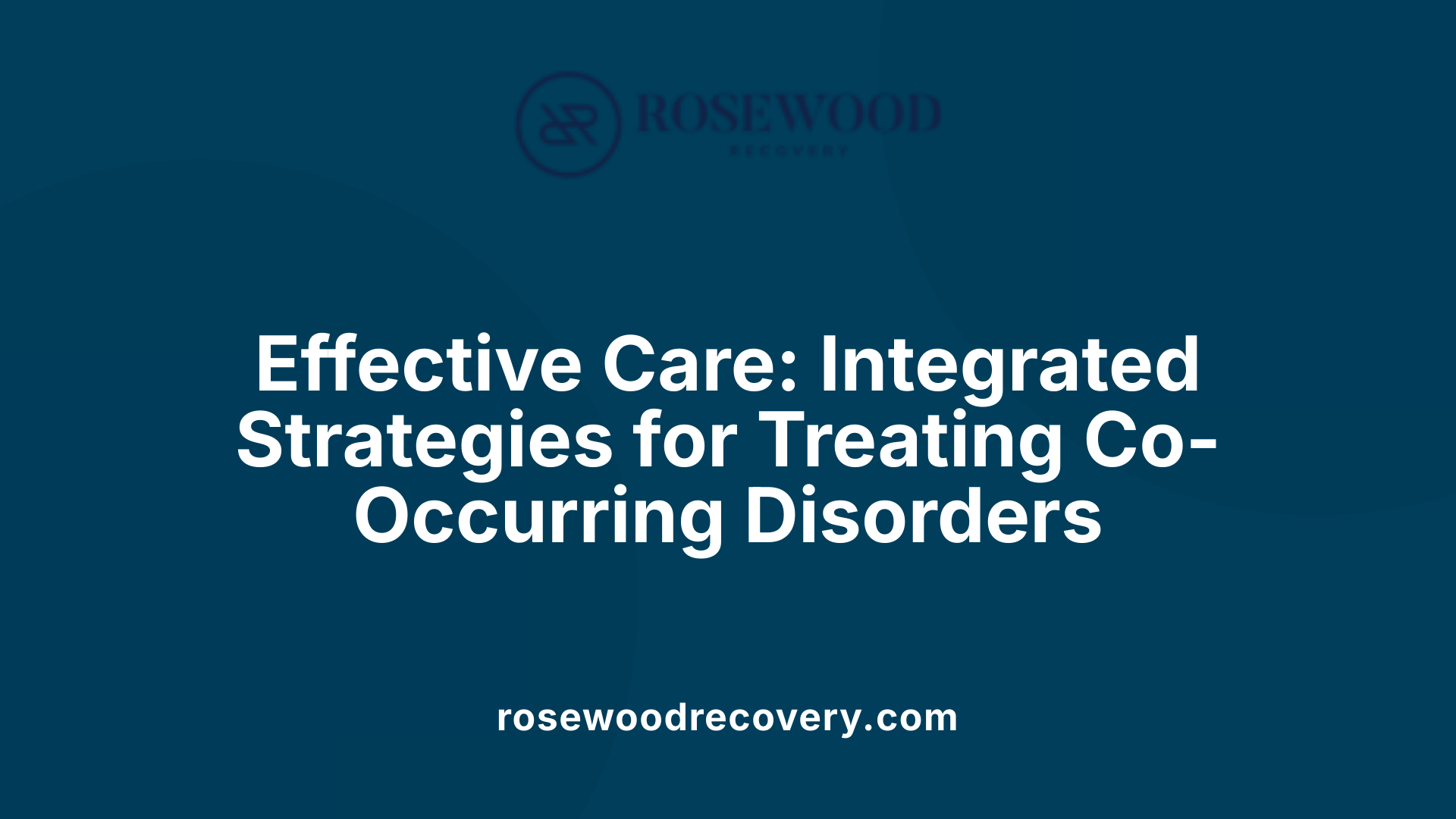
What treatment options and strategies are effective for co-occurring disorders?
Effective treatment for co-occurring disorders hinges on an integrated approach that simultaneously addresses both mental health issues and substance use problems. This dual focus ensures that neither condition is neglected, which greatly improves recovery outcomes.
A critical component is building a strong therapeutic relationship. Approaching clients with empathy and trust helps to overcome stigma, mistrust, and resistance. Motivational interviewing is a counseling technique frequently used to enhance motivation to change and engage individuals in the treatment process.
Behavioral therapies such as Cognitive Behavioral Therapy (CBT), Dialectical Behavior Therapy (DBT), and Contingency Management are foundational. These therapies help individuals develop coping strategies, manage triggers, and address underlying emotional or behavioral issues.
Medications also play an important role. For opioid, alcohol, and nicotine addictions, specific medications can lessen cravings and withdrawal symptoms. When used judiciously, medications can stabilize mood and reduce symptoms of mental health disorders, making behavioral therapies more effective.
Relapse prevention strategies are crucial, given the chronic nature of these disorders. Continuous monitoring of symptoms, medication adherence, and regular follow-up appointments help maintain progress. Support from peer groups such as Alcoholics Anonymous, Narcotics Anonymous, or specialized dual recovery programs fosters ongoing motivation and accountability.
In addition to clinical interventions, trauma-informed care is vital, especially since many co-occurring disorders stem from past traumatic experiences. This approach ensures that treatment does not re-traumatize and promotes healing.
Coordination among healthcare providers—psychiatrists, psychologists, counselors, and primary care physicians—is essential. Seamless communication allows for tailored treatment plans that adapt to the evolving needs of the individual.
Overall, a person-centered, comprehensive treatment plan that combines evidence-based therapies, appropriate medications, and strong peer and family support creates the best environment for sustained recovery. With consistent care and support, approximately half of individuals with co-occurring disorders respond well to integrated treatment programs, leading to improved quality of life and functioning.
Special Considerations and Populations

How do co-occurring disorders impact specific populations, such as adolescents?
Co-occurring disorders pose particular challenges for adolescents, affecting diagnosis, treatment, and overall outcomes. During this developmental stage, mental health conditions like anxiety, depression, ADHD, bipolar disorder, and psychosis frequently overlap with substance use disorders.
Many teens with mental health issues may turn to drugs or alcohol to self-medicate, which can increase the risk of developing full-fledged co-occurring disorders. Untreated mental health problems can lead to earlier onset of substance use, more severe addiction, and complicate treatment processes.
The presence of both mental health and substance use issues can undermine an adolescent's ability to adhere to treatment plans, increase the chances of relapse, and elevates the risk of overdose and suicidal behavior.
Effective intervention for this group requires an integrated approach that combines mental health care, substance use treatment, family involvement, and early detection strategies. Tailoring interventions to address the unique developmental needs of adolescents is key.
Early identification and concurrent treatment of co-occurring disorders can improve mental health outcomes, reduce the likelihood of long-term complications, and support healthier development into adulthood.
Addressing these issues proactively can significantly impact adolescents' future prospects, helping them build resilience and navigate mental health challenges more effectively.
Toward Effective and Holistic Management of Dual Diagnoses
Understanding co-occurring disorders in substance use treatment involves recognizing their prevalence, complex interrelations, neurobiological mechanisms, and tailored intervention strategies. An integrated, person-centered approach that combines comprehensive assessment, evidence-based therapies, medication management, and support systems is essential for effective recovery. Special populations, such as adolescents, require early, culturally sensitive interventions to prevent long-term complications. Continuous education for providers, patients, and caregivers, supported by accessible resources, ensures ongoing progress in managing these intertwined conditions. Ultimately, embracing a holistic view of mental health and substance use as interconnected challenges enables better outcomes, reduces health disparities, and fosters resilient, healthier communities.
References
- Co-Occurring Disorders and Other Health Conditions
- Co-Occurring Disorders and Health Conditions
- Dual Diagnosis (Co-Occurring Disorders)
- Finding Help for Co-Occurring Substance Use and Mental ...
- Co-occurring Disorders Facts for Families
- Guide to Co-Occurring Disorders in Adolescents
- Co-Occurring Conditions | Understand the Problem
- Co-Occurring Mental and Substance Use Disorders
- Dual Diagnosis: Substance Abuse and Mental Health

.avif)

.jpeg)
